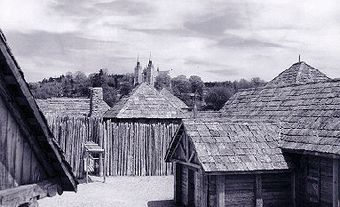Laval, Quebec, incorporated as a city in 1965, population 438,366 (2021 census), 422,993 (2016 census). Laval was formed by the merger of 14 municipalities: Chomedey, Duvernay, Laval-des-Rapides, Laval-Ouest, Pont-Viau, Sainte-Rose, Auteuil, Fabreville, Îles-Laval, Laval-sur-le-lac, Sainte-Dorothée, Saint-François, Saint-Vincent-de-Paul and Vimont. Laval is the third largest city in Quebec. It is located on Île Jésus, north of Île de Montréal. Laval is separated from Île de Montréal by the Rivière des Prairies and from the mainland to the north by the Rivière des Mille Îles. The city is named after François de Laval, the first Roman Catholic bishop of Quebec (1674-88) and onetime seigneur (1675-80) of Île Jésus.
Development
In 1636, Île Jésus was granted to the Jesuits, missionaries who played an important role in the history of New France. Previously known as a summer resort for Montrealers, Laval has become a large suburban city with an important manufacturing and industrial base. Since 1965, the city has grown significantly, from 170,000 residents to today's 422,993.
Economy
Laval’s traditional economic base, agriculture and limestone quarrying, has given way to metallurgical, pharmaceutical and food products industries. Its diversified economy is based primarily on the service sector, but it also has a strong manufacturing component. Part of the city's pharmaceutical sector is Institut Armand-Frappier, a research centre specializing in pharmacochemistry and part of the larger Institut national de la recherche scientifique.
In 1995, Laval Technopôle was created. This non-profit organization administered Laval's industrial parks and promoted the city's economic development. In 2015, Laval Technopôle closed and its function and duties were folded into the municipal bureaucracy.
Cultural Life
There are reminders of the old, rural character of Île Jésus throughout Laval, including 26 roadside crosses, riverside parks and heritage village centres. Some former villages include churches dating back to the mid-1850s, such as those found in Sainte-Rose and Saint-Vincent-de-Paul. Saint-Vincent-de-Paul is also well known for its fortress-like federal penitentiary, built in 1873.
The area around expressways 15 and 440 and Saint-Martin Boulevard is the new city centre, and includes a concentration of shopping malls and high-rise buildings. Other sites of interest include the Cosmodôme (Space Camp Canada) and Maison des arts de Laval. Musée Armand-Frappier is a science museum dedicated to the career of Armand Frappier.

 Share on Facebook
Share on Facebook Share on X
Share on X Share by Email
Share by Email Share on Google Classroom
Share on Google Classroom



